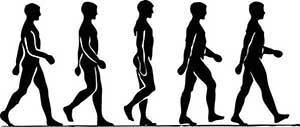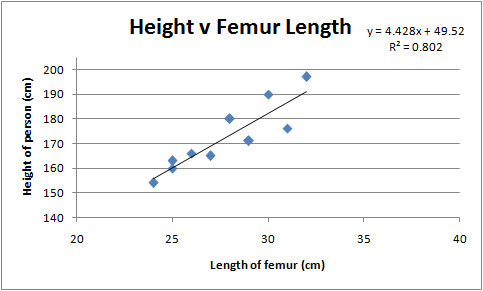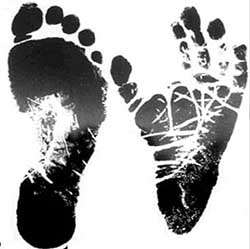Investigation: What is the Relationships Between Stride Length and the Bones of the Leg?

Objectives:
- Gather data from classmates to determine the relationship between foot length, leg length, height and stride.
- Reinforce terms related to the skeletal system
- Create a scatterplot and identify the line of best fit
Materials: Meter Stick or Tape Measure, Computer (Excel or Google Sheets) to Graph Data, or Graph Paper
Hypothesis: Write a statement that indicates which measurement (foot length, femur length, ulna length) can be used to predict height.
Measurements: All measurements should be done in centimeters. Gather data from 8 individuals, you can use data from your own group and share with another group to complete the table.
Foot length: distance from back of heel to toe
Femur length: distance from lateral epicondyle to acetabulum
Height: distance from floor to the top of the head
Ulna Length: distance between elbow and bulge of the styloid process at wrist
Proximal & Distal Phalanx of the thumb
| Foot Length | Thumb Length | Ulna Length | Femur Length | Height | |
| Subject 1 | |||||
| Subject 2 | |||||
| Subject 3 | |||||
| Subject 4 | |||||
| Subject 5 | |||||
| Subject 6 | |||||
| Subject 7 | |||||
| Subject 8 |
Assign each member of your group to graph one of the variables (foot, ulna, or femur length) and height. Height should be on the Y axis for all graphs, and the other bone lengths should be placed on the X axis. You will have four graphs in total Once you have your plots on the graph, you should draw a LINE OF BEST FIT.
Analyzing Data
1) Which graph shows the strongest relationship? In other words, which bone is the best predictor of a person's height?
How did you make this decision?
2) Lines of best fit are used to extrapolate data. For example, you can use the line to estimate a person's height based on femur length. The following graph was created using samples from 10 freshman students at a college.

A person has a femur length of 32 centimeters. Use the graph to estimate this person’s height: ________
A person has a femur length of 26 centimeters. Use the graph to estimate this person’s height: ________
3) Based on these lines, a regression formula has been developed for estimating a person's height.
For a female caucasoid:
Height = 2.47 * femur length + 54.10 plus or minus 3.72 cm.
If a female has a femur length of 158 cm, how tall would you estimate her to be?
Part II What is the Relationship Between Foot Length and Stride Length
Instructions:
1. Use the data from part 1 to complete height and foot data in cm.
1. Mark a distance of 30 meters, your instructor may have done this already in the
hallway.
2. Walk the length by counting the number of steps and complete the table
3. Calculate the stride (Distance / Number of Steps)
3. Measure the foot length (You can use your measurements from part 1)
| Height | Foot | Steps per 30 m | (Stride) 30 / # of Steps | |
| Subject 1 | ||||
| Subject 2 | ||||
| Subject 3 | ||||
| Subject 4 | ||||
| Subject 5 | ||||
| Subject 6 | ||||
| Subject 7 | ||||
| Subject 8 |
Analyzing Data:
Create another graph showing the relationship between stride and height and a graph showing the relationship between foot length and stride. Place Stride length on the X axis and height and foot length on the Y axis. Create plot points for each of your subjects and draw a LINE OF BEST FIT. Attach the graph to this page.
1) Do you see a pattern in the graphs? What seems to be the relationship between stride length and leg length? (Summarize in a complete sentence).
2) Using both sets of data, describe how you could determine a person’s height if you know his stride length.
Extension Questions
4) A burglary occurred and police identified two sets of footprints at the scene of the crime. Use the graphic shown to estimate the height of the two burglars based on their foot length and stride length. Defend your estimate by referencing data from any of the graphs you created in this activity.

5) Forensic scientists can also estimate the weight of a person based on footsteps. Design an experiment where you could test whether footsteps and weight can be correlated.
6) Paleontologists fund “footprint tracks” of apes, humans, and ancient hominids. Features of the tracks can provide information about size, gait, and even whether the animal was bipedal or quadrupedal. Compare the footprints shown of human (bipedal) and a chimpanzee (quadrupedal). List two similarities and two differences evident from the image.

